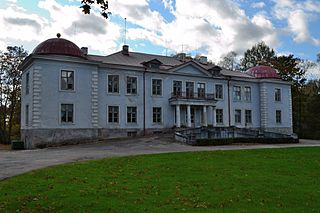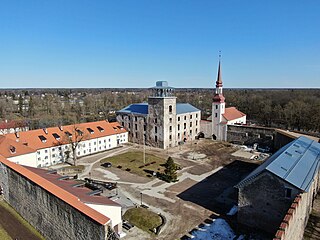
Jäneda is a small village in northern Estonia. It is located in Lääne-Viru County and is a part of Tapa municipality.

Vääna is a village in Harku Parish, Harju County in northern Estonia. It has a population of 266. Vääna is located about 20 km (12 mi) from the capital Tallinn.

Adavere is a small borough in Põltsamaa Parish, Jõgeva County in central Estonia. It has a population of 632. Just outside the town is the 'Estonian mainland midpoint symbol denoting'.

Riisipere is a small borough in the Saue Parish, Harju County, Estonia. Prior to the administrative reform of Estonian local governments in March 2017, Riisipere was the administrative center of Nissi Parish. Located on the Ääsmäe-Haapsalu road, its distance from Tallinn is 45 km, from Haapsalu 50 km, Märjamaa 30 km, Rapla 40 km.

Käru is a small borough in Türi Parish, Järva County, Estonia. Before the administrative reform in 2017, Käru was the administrative centre of Käru Parish.

Suuremõisa is a village in Hiiumaa Parish, Hiiu County in northwestern Estonia.

Roosna-Alliku is a small borough in Paide municipality, Järva County in northern-central Estonia. Prior to the 2017 administrative reform in Estonia of local governments, it was the administrative centre of Roosna-Alliku Parish.

Kabala is a village in Türi Parish, Järva County in central Estonia. From 1991 to 2005 it was the administrative seat of Kabala Parish.

Kolu is a village in Türi Parish, Järva County in central Estonia. Kolu railway station on the Tallinn - Viljandi railway line operated by Elron is a short distance from the village.

Vatla is a village in Lääneranna Parish, Pärnu County, in western Estonia.

Penijõe is a village in Lääneranna Parish, Pärnu County, in western Estonia; in the centre of Matsalu National Park.

Aaspere is a village in Haljala Parish, Lääne-Viru County, in northeastern Estonia. It is about 20 kilometres from Rakvere.

Palmse is a village in Haljala Parish, Lääne-Viru County, in northern Estonia, on the territory of Lahemaa National Park.

Sagadi is a village in Haljala Parish, Lääne-Viru County, in northern Estonia, located within the territory of Lahemaa National Park.

Maidla is a village in Rapla Parish, Rapla County in northwestern Estonia. Between 1991 and 2017 the village was located in Juuru Parish.

Seli is a village in Rapla Parish, Rapla County in northwestern Estonia.

Koluvere Castle, also Koluvere Episcopal Castle,, is a castle in Koluvere, Lääne County, in western Estonia.

Põltsamaa Castle, also Põltsamaa Order Castle,, is a castle in Põltsamaa, Jõgeva County, in eastern Estonia.

Maidla is a village in Lüganuse Parish, Ida-Viru County in northeastern Estonia.

Mooste is a small borough in Põlva Parish, Põlva County, Estonia.






















